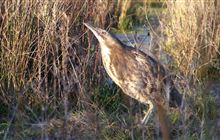Double-up means dip for bittern population
Archived content: This media release was accurate on the date of publication.
Introduction
New research highlights the importance of New Zealand’s wetlands for one of our most secretive native birds, the Australasian bittern or matuku, Conservation Minister Eugenie Sage said today on World Wetlands Day.Date: 02 February 2019 Source: Office of the Minister of Conservation
GPS tracking of matuku/bittern has, for the first time, revealed that this threatened swamp dweller flies more than 300 km between wetlands in the eastern South Island as well as large distances between North Island wetland sites. Previously it was thought bittern ranged only small distances from their home wetlands.
The DOC-led study shows that bittern rely on a network of wetlands, to feed and breed in. It also means matuku/bittern may be rarer than previously thought as birds have probably been double-counted in local counts in different parts of the country.
“Bittern are secretive birds that use a freeze pose to hide among wetland vegetation and are expert at evading people. The GPS tracking has given new insights into their behaviour and habitat requirements,” Eugenie Sage said.
“In New Zealand, we have lost 90 per cent of our natural inland wetlands since the mid 1800s. In addition, 74 percent of our remaining wetlands are less than 10 ha in size, and wetland drainage and damage is continuing.
“This research shows the importance of the last 10 percent of our wetlands across the country to enable wetland specialists like bittern to survive.”
In the study male bittern were tracked flying 330 km from Te Waihora/Lake Ellesmere in Canterbury to wetlands near Blenheim during the breeding season last spring. They also flew 117 km from Whangamarino wetland in north Waikato to south Kaipara and from Whangamarino to Kaituna in the Bay of Plenty.
“Wetlands are home to precious wildlife and plants including rare and threatened species like bittern, Canterbury mudfish and swamp helmet orchid. They also act as nature's 'kidneys' filtering sediments and nutrients from run-off and as sponges in the landscape helping sustain rivers and streams in times of drought,” Eugenie Sage said.
“While DOC, councils, iwi, Fish & Game, community groups, supportive private landowners and businesses are making good progress in managing and restoring many significant wetlands, we need to value all of our remaining wetlands and do more to protect them.”
Additional information
Matuku/bittern have declined dramatically in New Zealand with their distribution shrinking by 50 percent since records began before 1900. Their populations are highly fragmented. It’s estimated there are less than 1000 birds in New Zealand and a similar number in Australia, where bittern are also found. Bittern has the highest threat status of 'nationally critical'.
As well as habitat loss, the ground-nesting matuku/bittern is vulnerable to predators such as stoats, ferrets and feral cats. Bittern eat small eels and fish as well as insects and poor water quality can affect their food supply. Climate change also poses uncertainties with the risk that coastal inundation could affect freshwater wetlands, limiting plants like raupō that bittern prefer to nest in.
DOC’s bittern research is part of its Arawai Kākāriki freshwater programme and is supported by organisations such as Environment Canterbury, Bay of Plenty Regional Council, BirdsNZ, Ducks Unlimited and Hawkes Bay Forest & Bird.
World Wetlands Day is celebrated every year on 2 February to raise global awareness about the value of wetlands for humanity and the planet. It also marks the adoption of the Ramsar Convention on Wetlands, an international agreement to recognise wetlands of international importance (Ramsar sites) and encourage the wise management of all wetlands. The theme for WWD this year set by the Ramsar Secretariat is wetlands and climate change.
The Ramsar Convention which was established in 1971 includes 170 countries. In total there are 2,339 Ramsar sites.
The New Zealand Government became a signatory to the Convention in 1976, and currently has six Ramsar sites, these are:
- Firth of Thames, Waikato
- Whangamarino wetland, Waikato
- Kopuatai Peat Dome, Waikato
- Manawatu River Estuary, Manawatu
- Farewell Spit, Nelson
- Awarua Wetland/Waituna Lagoon, Southland
DOC has freshwater programmes such as Arawai Kākāriki and Living Water funding wetland management at its Ramsar sites and is currently investigating the potential for future Ramsar wetlands.
Contact
For media enquiries contact:
Phone: +64 4 496 1911
Email: media@doc.govt.nz
Emma Williams, DOC bittern research lead
Mobile: +64 27 254 8952

